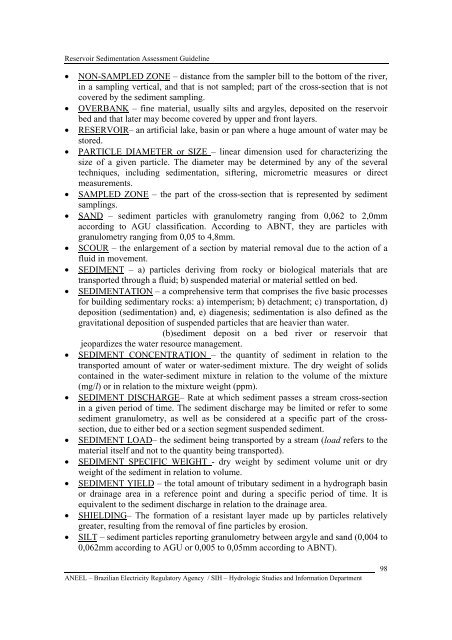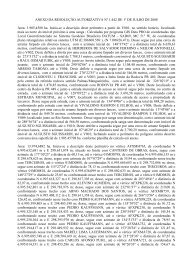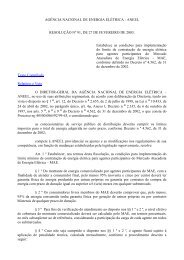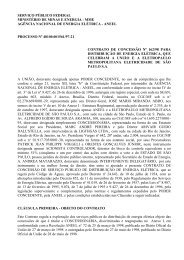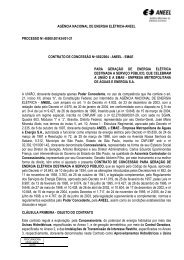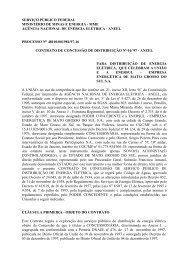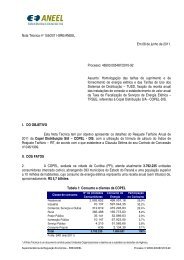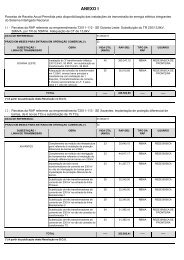RESERVOIR SEDIMENTATION ASSESSMENT GUIDELINE - Aneel
RESERVOIR SEDIMENTATION ASSESSMENT GUIDELINE - Aneel
RESERVOIR SEDIMENTATION ASSESSMENT GUIDELINE - Aneel
Create successful ePaper yourself
Turn your PDF publications into a flip-book with our unique Google optimized e-Paper software.
Reservoir Sedimentation Assessment Guideline• NON-SAMPLED ZONE – distance from the sampler bill to the bottom of the river,in a sampling vertical, and that is not sampled; part of the cross-section that is notcovered by the sediment sampling.• OVERBANK – fine material, usually silts and argyles, deposited on the reservoirbed and that later may become covered by upper and front layers.• <strong>RESERVOIR</strong>– an artificial lake, basin or pan where a huge amount of water may bestored.• PARTICLE DIAMETER or SIZE – linear dimension used for characterizing thesize of a given particle. The diameter may be determined by any of the severaltechniques, including sedimentation, siftering, micrometric measures or directmeasurements.• SAMPLED ZONE – the part of the cross-section that is represented by sedimentsamplings.• SAND – sediment particles with granulometry ranging from 0,062 to 2,0mmaccording to AGU classification. According to ABNT, they are particles withgranulometry ranging from 0,05 to 4,8mm.• SCOUR – the enlargement of a section by material removal due to the action of afluid in movement.• SEDIMENT – a) particles deriving from rocky or biological materials that aretransported through a fluid; b) suspended material or material settled on bed.• <strong>SEDIMENTATION</strong> – a comprehensive term that comprises the five basic processesfor building sedimentary rocks: a) intemperism; b) detachment; c) transportation, d)deposition (sedimentation) and, e) diagenesis; sedimentation is also defined as thegravitational deposition of suspended particles that are heavier than water.(b)sediment deposit on a bed river or reservoir thatjeopardizes the water resource management.• SEDIMENT CONCENTRATION – the quantity of sediment in relation to thetransported amount of water or water-sediment mixture. The dry weight of solidscontained in the water-sediment mixture in relation to the volume of the mixture(mg/l) or in relation to the mixture weight (ppm).• SEDIMENT DISCHARGE– Rate at which sediment passes a stream cross-sectionin a given period of time. The sediment discharge may be limited or refer to somesediment granulometry, as well as be considered at a specific part of the crosssection,due to either bed or a section segment suspended sediment.• SEDIMENT LOAD– the sediment being transported by a stream (load refers to thematerial itself and not to the quantity being transported).• SEDIMENT SPECIFIC WEIGHT - dry weight by sediment volume unit or dryweight of the sediment in relation to volume.• SEDIMENT YIELD – the total amount of tributary sediment in a hydrograph basinor drainage area in a reference point and during a specific period of time. It isequivalent to the sediment discharge in relation to the drainage area.• SHIELDING– The formation of a resistant layer made up by particles relativelygreater, resulting from the removal of fine particles by erosion.• SILT – sediment particles reporting granulometry between argyle and sand (0,004 to0,062mm according to AGU or 0,005 to 0,05mm according to ABNT).ANEEL – Brazilian Electricity Regulatory Agency / SIH – Hydrologic Studies and Information Department98


